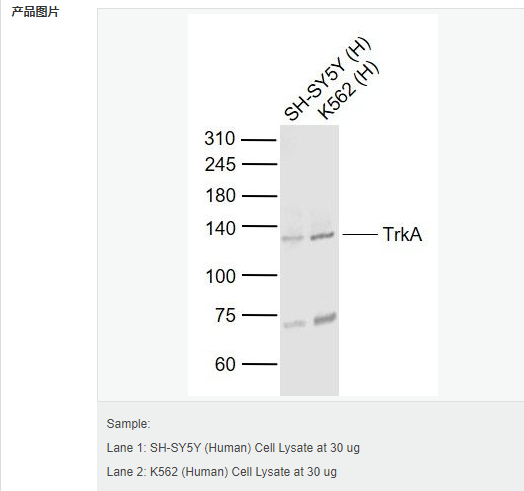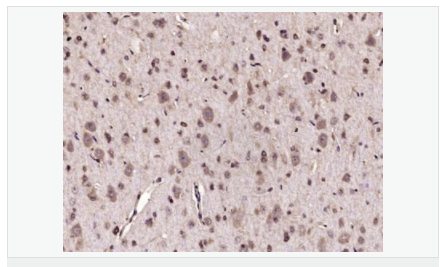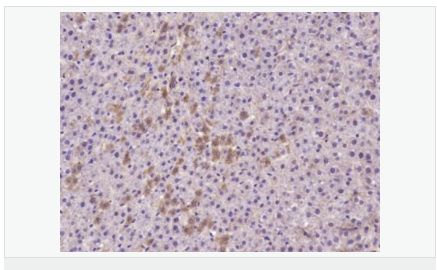

貨號(hào)
產(chǎn)品規(guī)格
售價(jià)
備注
BN41624R-50ul
50ul
¥1486.00
交叉反應(yīng):Human,Rat(predicted:Mouse,Pig,Cow,Horse,Sheep) 推薦應(yīng)用:WB,IHC-P,IHC-F,IF,ELISA
BN41624R-100ul
100ul
¥2360.00
交叉反應(yīng):Human,Rat(predicted:Mouse,Pig,Cow,Horse,Sheep) 推薦應(yīng)用:WB,IHC-P,IHC-F,IF,ELISA
BN41624R-200ul
200ul
¥3490.00
交叉反應(yīng):Human,Rat(predicted:Mouse,Pig,Cow,Horse,Sheep) 推薦應(yīng)用:WB,IHC-P,IHC-F,IF,ELISA
產(chǎn)品描述
| 英文名稱(chēng) | TrkA |
| 中文名稱(chēng) | 酪氨酸激酶受體A抗體 |
| 別 名 | CIPA; CIPA; DKFZp781I14186; gp140trk; High affinity nerve growth factor receptor; High affinity nerve growth factor receptor precursor; High affinity nerve growth factor receptor precursor; MTC; MTC; neurotrophic tyrosine kinase receptor type 1; neurotrophic tyrosine kinase receptor type 1; Ntrk 1; Ntrk1; Ntrk1; NTRK1_HUMAN; Oncogene TRK; Oncogene TRK; p140 TrkA; p140-TrkA; TRK 1; Trk A; TRK; TRK; Trk-A; TRK1; TRK1 transforming tyrosine kinase protein; TRK1-transforming tyrosine kinase protein; Tropomyosin-related kinase A; Tyrosine kinase receptor A; Tyrosine kinase receptor; Tyrosine Receptor Kinase A. |
| 抗體來(lái)源 | Rabbit |
| 克隆類(lèi)型 | Polyclonal |
| 交叉反應(yīng) | Human, Rat, (predicted: Mouse, Pig, Cow, Horse, Sheep, ) |
| 產(chǎn)品應(yīng)用 | WB=1:500-2000 ELISA=1:5000-10000 IHC-P=1:100-500 IHC-F=1:100-500 ICC=1:100-500 IF=1:100-500 (石蠟切片需做抗原修復(fù)) not yet tested in other applications. optimal dilutions/concentrations should be determined by the end user. |
| 分 子 量 | 84kDa |
| 細(xì)胞定位 | 細(xì)胞漿 細(xì)胞膜 |
| 性 狀 | Liquid |
| 濃 度 | 1mg/ml |
| 免 疫 原 | KLH conjugated synthetic peptide derived from human TrkA:101-200/796 <Extracellular> |
| 亞 型 | IgG |
| 純化方法 | affinity purified by Protein A |
| 儲(chǔ) 存 液 | 0.01M TBS(pH7.4) with 1% BSA, 0.03% Proclin300 and 50% Glycerol. |
| 保存條件 | Shipped at 4℃. Store at -20 °C for one year. Avoid repeated freeze/thaw cycles. |
| PubMed | PubMed |
| 產(chǎn)品介紹 | The Trk family of nerve growth factor receptors includes Trk A(also referfed to as Trk A gp140),Trk B and Trk C. The prototype member of this gene family, Trk A, encodes a 140 kDa cell surface receptor , gp140, the expression of which is restricted in vivo to neurons of the sensory spinal and cranial gangliaof neurocrest origin. Nerve growth factor (NGF) stimulates tyrosine phosphorylation of Trk gp 140 in neural cell lines and in embryonic dorsal root ganglia. By comparison, BDNF and to a lesser extent, NT-3, but not NGF, can induce tyrosine phophorylayion of Trk B gp 145. The third member of the Trk receptor family, Trk C incodes a 140 kDa protein, Trk C gp140, that is preferentially expressed in brain tissue and primarily functions as a receptor for NT-3.An additional component of the Trk receptor complex, NGFR p175, binds to neurotrophic factors with low affinity but is required for efficient signaling. NGFR p175 accelerates Trk activation and may recruit downstream dffector molecules to the ligand-bound receptor complex. Function: Receptor tyrosine kinase involved in the development and the maturation of the central and peripheral nervous systems through regulation of proliferation, differentiation and survival of sympathetic and nervous neurons. High affinity receptor for NGF which is its primary ligand, it can also bind and be activated by NTF3/neurotrophin-3. However, NTF3 only supports axonal extension through NTRK1 but has no effect on neuron survival. Upon dimeric NGF ligand-binding, undergoes homodimerization, autophosphorylation and activation. Recruits, phosphorylates and/or activates several downstream effectors including SHC1, FRS2, SH2B1, SH2B2 and PLCG1 that regulate distinct overlapping signaling cascades driving cell survival and differentiation. Through SHC1 and FRS2 activates a GRB2-Ras-MAPK cascade that regulates cell differentiation and survival. Through PLCG1 controls NF-Kappa-B activation and the transcription of genes involved in cell survival. Through SHC1 and SH2B1 controls a Ras-PI3 kinase-AKT1 signaling cascade that is also regulating survival. In absence of ligand and activation, may promote cell death, making the survival of neurons dependent on trophic factors. Isoform TrkA-III is resistant to NGF, constitutively activates AKT1 and NF-kappa-B and is unable to activate the Ras-MAPK signaling cascade. Antagonizes the anti-proliferative NGF-NTRK1 signaling that promotes neuronal precursors differentiation. Isoform TrkA-III promotes angiogenesis and has oncogenic activity when overexpressed. Subunit: Exists in a dynamic equilibrium between monomeric (low affinity) and dimeric (high affinity) structures. Homodimerization is induced by binding of a NGF dimer. Interacts with SQSTM1; bridges NTRK1 to NGFR. Forms a ternary complex with NGFR and KIDINS220; this complex is affected by the expression levels of KIDINS220 and an increase in KIDINS220 expression leads to a decreased association of NGFR and NTRK1 (By similarity). Interacts with SH2D1A; regulates NTRK1 (By similarity). Interacts (phosphorylated upon activation by NGF) with SHC1; mediates SHC1 phosphorylation and activation. Interacts (phosphorylated upon activation by NGF) with PLCG1; mediates PLCG1 phosphorylation and activation. Interacts (phosphorylated) with SH2B1 and SH2B2. Interacts with GRB2. Interacts with PIK3R1. Interacts with FRS2. Interacts with SORT1; may regulate NTRK1 anterograde axonal transport. Interacts with RAB7A. Subcellular Location: Cell membrane; Single-pass type I membrane protein. Early endosome membrane; Single-pass type I membrane protein. Note=Internalized to endosomes upon binding of NGF or NTF3 and further transported to the cell body via a retrograde axonal transport. Tissue Specificity: Isoform TrkA-I is found in most non-neuronal tissues. Isoform TrkA-II is primarily expressed in neuronal cells. TrkA-III is specifically expressed by pluripotent neural stem and neural crest progenitors. Post-translational modifications: Ligand-mediated autophosphorylation. Interaction with SQSTM1 is phosphotyrosine-dependent. Autophosphorylation at Tyr-496 mediates interaction and phosphorylation of SHC1. N-glycosylated (Probable). Isoform TrkA-I is N-glycosylated. Ubiquitinated. Undergoes polyubiquitination upon activation; regulated by NGFR. Ubiquitination regulates the internalization of the receptor (By similarity) DISEASE: Defects in NTRK1 are a cause of congenital insensitivity to pain with anhidrosis (CIPA) [MIM:256800]. CIPA is characterized by a congenital insensitivity to pain, anhidrosis (absence of sweating), absence of reaction to noxious stimuli, self-mutilating behavior, and mental retardation. This rare autosomal recessive disorder is also known as congenital sensory neuropathy with anhidrosis or hereditary sensory and autonomic neuropathy type IV or familial dysautonomia type II. Defects in NTRK1 are a cause of thyroid papillary carcinoma (TPC) [MIM:188550]. TPC is a common tumor of the thyroid that typically arises as an irregular, solid or cystic mass from otherwise normal thyroid tissue. Papillary carcinomas are malignant neoplasm characterized by the formation of numerous, irregular, finger-like projections of fibrous stroma that is covered with a surface layer of neoplastic epithelial cells. Note=Chromosomal aberrations involving NTRK1 are found in thyroid papillary carcinomas. Translocation t(1;3)(q21;q11) with TFG generates the TRKT3 (TRK-T3) transcript by fusing TFG to the 3'-end of NTRK1; a rearrangement with TPM3 generates the TRK transcript by fusing TPM3 to the 3'-end of NTRK1; an intrachromosomal rearrangement that links the protein kinase domain of NTRK1 to the 5'-end of the TPR gene forms the fusion protein TRK-T1. TRK-T1 is a 55 kDa protein reacting with antibodies against the C-terminus of the NTRK1 protein. Similarity: Belongs to the protein kinase superfamily. Tyr protein kinase family. Insulin receptor subfamily. Contains 2 Ig-like C2-type (immunoglobulin-like) domains. Contains 2 LRR (leucine-rich) repeats. Contains 1 LRRCT domain. Contains 1 protein kinase domain. SWISS: P04629 Gene ID: 4914 Database links: Entrez Gene: 4914 Human Entrez Gene: 18211 Mouse Omim: 191315 Human SwissProt: P04629 Human SwissProt: Q3UFB7 Mouse Unigene: 406293 Human Unigene: 80682 Mouse Unigene: 39098 Rat Important Note: This product as supplied is intended for research use only, not for use in human, therapeutic or diagnostic applications. |


